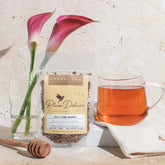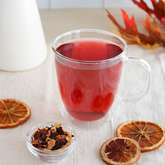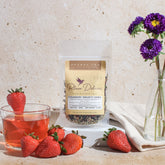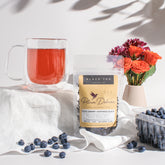As soon as springtime temperatures start to creep past winter-coat-required levels, my thoughts and tastes immediately turn to iced tea over my usual hot cuppa in the mornings. I’ve become known around my office as the iced tea lady (a title I’ll proudly accept), strolling into work with an impressively-sized 32 ounces of freshly made iced tea every day.
I frequently get questions from interested co-workers and friends about my methods, and to my surprise, they usually seem to be pretty intimidated by the process of successfully making iced tea. Little do they know just how uncomplicated and easy-peasy the iced tea-making process can be!
Far and away, the most common question I get from inquiring minds tends to be, “Really, can you brew tea in cold water?” And friends, I am happy to report that the answer is a resounding YES.
Not only is cold brewed iced tea tasty and simple, but it also boasts some great benefits even beyond traditionally-brewed hot teas. These cold brewed teas are great for your tastebuds and perfect for summer sipping.

Cold Brew Benefits
First and foremost, let’s talk about the great benefits of cold brewing teas. As tea drinkers, most of us know that the water temperature we use to brew along with steeping time can make or break a cup. Some leaves can be finicky, others risk bitterness if we let them steep too long. Not so with cold brewed tea! Brewing tea overnight (or if you’re antsy, for a handful of hours) in cold water removes all chances at bitterness or a funky taste; in fact, you can even leave the leaves in your cup as you sip with no taste repercussions. Brewing tea in cold water can be done, friends!
Why is this so? When you make iced tea with cold water it allows for fewer tannins (often what causes those bitter flavors in an over-brewed cup) to draw into the cup while steeping, leaving a smoother, fresher flavor and no risk of unsavory flavors -- regardless of how long you leave your leaves to steep! For the best brew, I’ve found that leaving teas overnight gives the tastiest results, though for those in a hurry, leaves can be left for even just 4-6 hours and still give great flavor.
A secondary benefit to cold-brewing tea, particularly loose leaf? Those leaves can be brewed into a great tea yet again! Second-steeping works great with loose leaf teas (especially a high quality loose-leaf, like one of Plum Deluxe’s many iced loose leaf offerings). This in particular is why I like to sip my iced tea in a glass or jar with my tea still floating around; as soon as I’ve finished my cup, I simply add some more fresh cold water, and let my leaves do their thing a second time around. Not only can you brew tea in cold water, now you can see why there are so many benefits to doing so!

How to Cold Brew Tea
Now that we know why to make iced tea with cold water, let’s talk about the how! So often, the process of cold brewing (or just making iced tea in general) can seem intimidating to even the most seasoned tea drinker. Like we mentioned above, loose tea leaves respond almost entirely differently to cold water than they do hot, and for those who’ve grown accustomed to brewing their cups hot every morning, noon, and night, switching things up seems to be an entirely different ballgame. Luckily, I’d even go so far as to say that cold brewing tea is foolproof, friends.
There are many different ways to brew your cup of iced tea, but today, we’re going to be talking about the easiest, so-simple-anyone-can-do it method to brew loose leaf tea in cold water.
All you need? A vessel (I love the Plum Deluxe mason jar brewing kit), your tea, and cold water!
Start with a teaspoon of tea for every eight ounces of water used (typically, you’re going to want to brew your iced tea twice as strong as you would a typical cup of hot tea). If I’m making a large, 32-ounce mason jar of iced tea, I’ll throw in four teaspoons of tea. Scale up as needed for various pitcher sizes, etc.
Once you’ve measured your tea into your brewing vessel of choice, top it with fresh, cold water, give it a little shake or stir to make sure all the leaves get saturated with water, close the lid, and stick in your fridge. As mentioned above, you can leave your tea in the fridge as long as you’d like, but overnight yields the best results — and no cold brewed teas should be left for less than four to six hours for the best flavor.
Once you’ve given your tea time to do its thing, all you need to do is simply strain the leaves (or let them continue to mingle in your water), top up with some ice and whichever add-ins you prefer (I love a splash of lemonade in my iced teas), and you’re ready to sip. Or transfer your tea into your cold cup of choice and then get your mason jar ready to brew another batch!
Crafting the perfect cup of iced tea couldn’t be simpler or more delicious for the summertime!

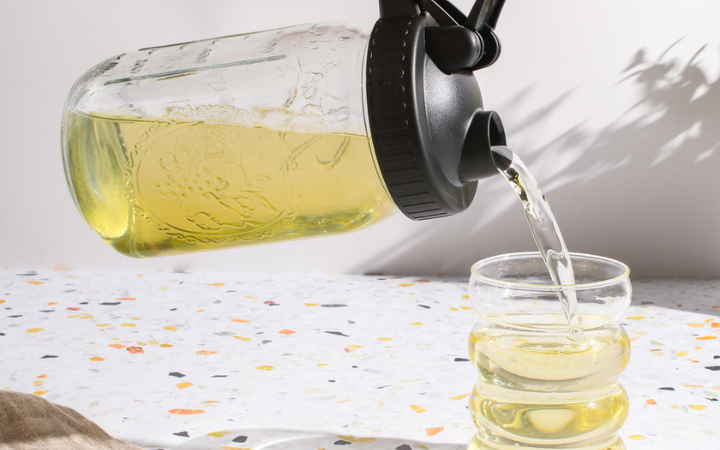
![Snow Day Sips Winter Tea Variety Pack [6-Pack of Flavors]](http://www.plumdeluxe.com/cdn/shop/files/holidayTeaVarietyPack_3.png?v=1766043158&width=165)
![Winter Tea Variety Pack [6-Pack Variety of Flavors]](http://www.plumdeluxe.com/cdn/shop/files/2.03-1080x1080-PlumDeluxe-IT-205020.png?v=1762440068&width=165)


